The Sandy Bridge Preview
by Anand Lal Shimpi on August 27, 2010 2:38 PM ESTAdobe Photoshop CS4 Performance
To measure performance under Photoshop CS4 we turn to the Retouch Artists’ Speed Test. The test does basic photo editing; there are a couple of color space conversions, many layer creations, color curve adjustment, image and canvas size adjustment, unsharp mask, and finally a gaussian blur performed on the entire image.
The whole process is timed and thanks to the use of Intel's X25-M SSD as our test bed hard drive, performance is far more predictable than back when we used to test on mechanical disks.
Time is reported in seconds and the lower numbers mean better performance. The test is multithreaded and can hit all four cores in a quad-core machine.
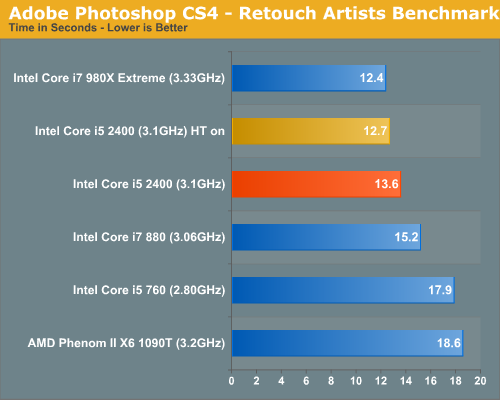
Right off the bat Sandy Bridge is killer. In our Photoshop test it’s faster than its closest quad-core price competitor, faster than its identically clocked Lynnfield, faster than AMD’s fastest and loses out only to Intel’s $999 Core i7 980X. That being said, it only takes about 9% longer to complete our benchmark than the 980X.
DivX 6.5.3 with Xmpeg 5.0.3
Our DivX test is the same DivX / XMpeg 5.03 test we've run for the past few years now, the 1080p source file is encoded using the unconstrained DivX profile, quality/performance is set balanced at 5 and enhanced multithreading is enabled:
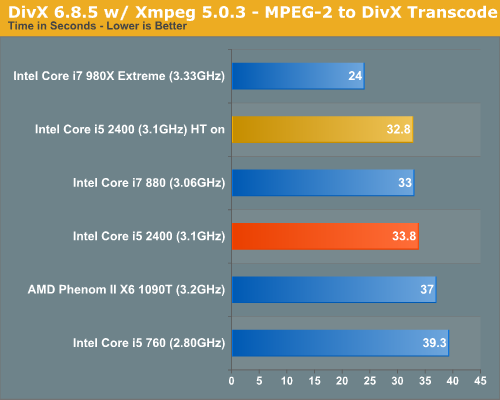
While not the most stressful encoding test, it’s still a valid measure of performance and once again, Sandy Bridge is faster than all. In this case we’re faster than the Core i5 760 (~16%) and just behind the Core i7 880. Clock for clock there's not a huge improvement in performance here (HT doesn't seem to do much), it's just a better value than the 760 assuming prices remain the same.
x264 HD Video Encoding Performance
Graysky's x264 HD test uses the publicly available x264 encoder to transcode a 4Mbps 720p MPEG-2 source. The focus here is on quality rather than speed, thus the benchmark uses a 2-pass encode and reports the average frame rate in each pass.
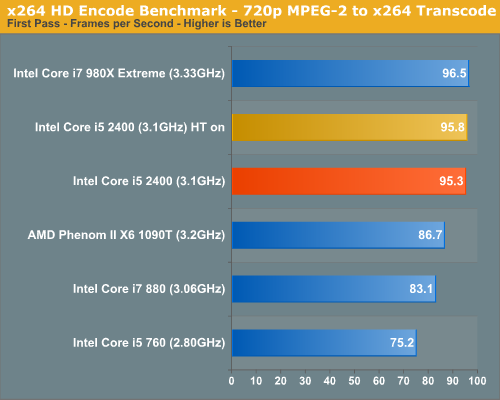
Lightly threaded performance is much improved - the 2400 is 14.6% faster than the Core i7 880.
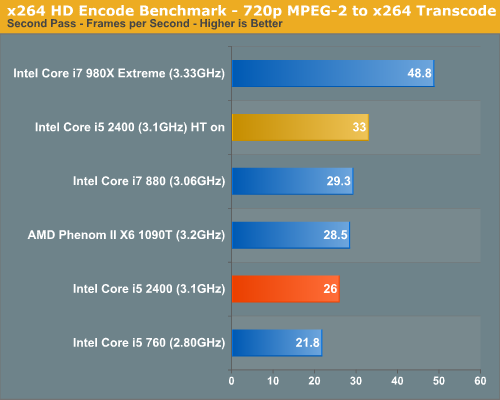
The actual encoding pass favors more threads, so we see a big improvement over the 760 (19%) but it falls short of the Core i7 880. Turn HT on and we get a 12.6% improvement over an identically clocked/configured Lynnfield.
Note that CPU based video encoding performance may not matter if Intel implemented a good video transcode engine in Sandy Bridge.
Windows Media Encoder 9 x64 Advanced Profile
In order to be codec agnostic we've got a Windows Media Encoder benchmark looking at the same sort of thing we've been doing in the DivX and x264 tests, but using WME instead.
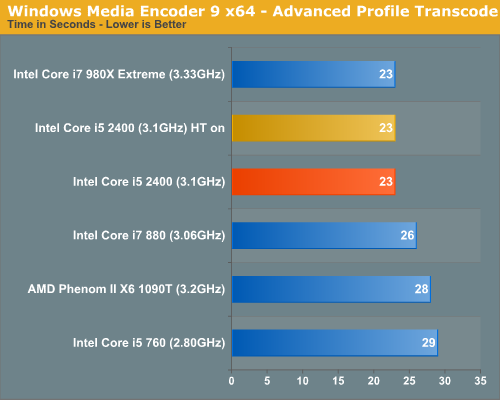
Performance in WME rarely scales anymore. Our benchmark doesn’t scale well beyond 4 cores and the only hope for performance are increases in clock speed or IPC. Sandy Bridge delivers the latter.
A 20% increase in performance vs. the similarly clocked 880 in a test that doesn’t scale with anything but IPC tells you a lot. Compared to the Core i5 760, Sandy Bridge is 26% faster.










200 Comments
View All Comments
foundchild1 - Friday, August 27, 2010 - link
"For example, today the fastest LGA-1156 processor is the Core i7 880. When Sandy Bridge launches early next year, the fastest LGA-1155 processor will be the Core i7 2600."Shouldn't the second one also read LGA-1156? Are they changing the pin count/socket for this 'tock'?
foundchild1 - Friday, August 27, 2010 - link
Well, that's me being an idiot and not reading the whole article first... New socket indeed.medi01 - Saturday, August 28, 2010 - link
So intel has locked multtipliers because of some other evil companies, eh? To protect the consumers, right?What a shame... :(
jfelano - Sunday, August 29, 2010 - link
Did you even read the article???? Yes its s1155.wazzap123 - Thursday, November 18, 2010 - link
The story of how caches are going to work in the 8+ core world is getting exciting. I like the overview at the daily circuit that summarizes how Niagara 3, Tilera Gx-100, and BlueGene/P processors weigh in on the issue toohttp://www.dailycircuitry.com/2010/11/progress-in-...
dendysutrisna - Friday, August 12, 2011 - link
The Apple iMac 21.5inch is a computer machine which uses the power of Intel Core i5-2400. Look at these page: http://www.bestdealscomputers.net/desktops/new-app... Processors like that, thanks to its strength, could draw the attention of everyone, even computer vendors at the level Apple also has without a doubt to hook them.Grooveriding - Friday, August 27, 2010 - link
It's hard to wade through all this data so quickly. That said, as far as overclocking, the new 2011 socket will be the successor to 1366 ?I hope with all these new overclocking controls there will still be that mainstay $300 CPU that can overclock to some extreme performance. Meaning a successor to the i7 920/930 that can deliver the amazing performance those can overclocked.
I hope this is not the death knell for such a CPU and Intel is expecting us to fork over $1000 for that performance level.
BSMonitor - Friday, August 27, 2010 - link
Good question, but judging by the road map, the Extreme and Performance segments are still Gulftown Processors. I think the 1366 stays for Gulftown.Casper42 - Saturday, August 28, 2010 - link
On the 2P Server side of things, I have been told there will be a Westmere v2 coming in January 2011.This is probably the same family that will produce the i7 990 and the other 1366 chips on the chart that don't exist yet. The Xeon 5600 and 970/980 are damn near identical aside from QPI Links.
Being those are being released in Jan, I wouldn't expect to see a socket 2011 desktop part until basically a year from now.
They will once again be a close relative to the 2P Server family. The socket for the 2P Servers will be Socket R and will be Quad Channel memory as well as supposedly having PCIe 3.0.
bitzao - Friday, August 27, 2010 - link
Yeah but.... will it run Starcraft II ? (on medium)